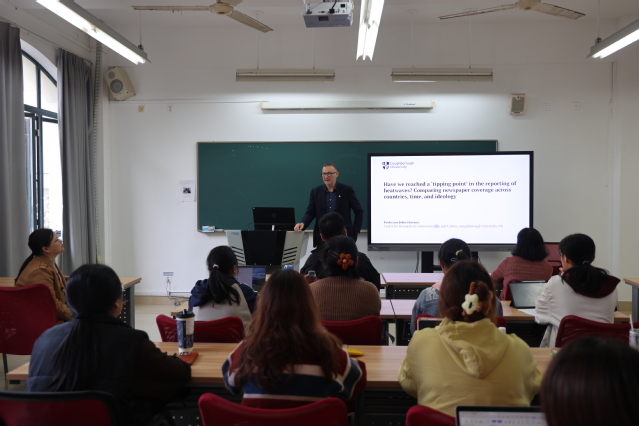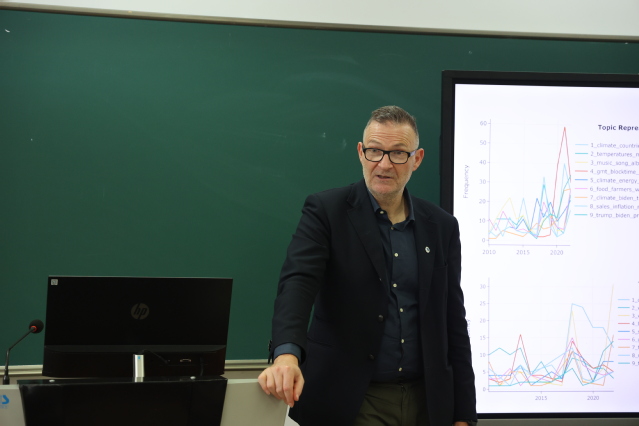
Written by Chen Wuyue and Li Lun
Translated by Guo Yishun
On November 13, 2024, Professor John Downey, Vice President of Loughborough University and President of the European Communication Research and Education Association (ECREA), delivered a thought-provoking lecture at our university titled “Have We Reached a ‘Tipping Point’ in Climate Change Reporting? How Mainstream Newspapers Cover Heatwaves Across Time and Countries.” Hosted by Professor Yan Yining, the lecture delved into the evolving role of media in reporting climate change, with a particular focus on heatwaves as a central marker of global warming.
Professor Downey opened his talk by examining the growing frequency and intensity of extreme weather events, specifically heatwaves, and their significance in climate change communication. While definitions of heatwaves vary by country and region, Downey emphasized their crucial role in conveying the impacts of climate change to the public. Drawing on data from the Intergovernmental Panel on Climate Change (IPCC), he explained that heatwaves are defined as prolonged periods of excessively high temperatures, often linked to broader climate shifts.
A key aspect of Downey’s lecture was the analysis of how journalists have approached heatwave reporting. His research team analyzed over a decade’s worth of coverage (2010–2022) from 18 mainstream newspapers across six countries. By employing methods such as frequency statistics, named entity recognition, and topic modeling, the study tracked shifts in media attention to heatwaves and examined how often climate change was mentioned in connection with these events.

The findings were striking. Downey highlighted a significant surge in heatwave coverage beginning in 2018. Heatwave-related reports saw marked increases in countries like the UK, India, and China, where national heat events directly influenced media attention. However, in the US and Australia, the connection between heatwaves and news coverage was less consistent. Notably, Canada saw relatively little coverage until 2021, when a record-breaking heatwave caused a dramatic spike in media reporting.
An interesting trend identified by Downey was the ideological divide in how newspapers approached climate change reporting. Left-leaning and center-left publications were found to cover heatwaves more extensively and to make stronger links between extreme weather and climate change. These papers also prioritized expert voices, especially environmental scientists, and frequently cited IPCC findings. In contrast, right-leaning outlets were slower to adopt these connections. However, post-2018, Downey noted a shift in this pattern, with greater convergence across ideological lines, as more mainstream newspapers began explicitly connecting heatwaves to climate change.
The lecture provided valuable insights into the complexities of climate change reporting and the role of the media in shaping public understanding of environmental issues. During the subsequent Q&A session, Professor Downey addressed student questions on topics ranging from research methodology to the challenges of reporting climate science. He encouraged students to think critically about the role of media in environmental advocacy and to continue exploring this important field of study.

 |Hongkou Campus|550 Dalian Road (W), Shanghai 200083, China |Songjiang Campus|1550 Wenxiang Road, Shanghai 201620, China
|Hongkou Campus|550 Dalian Road (W), Shanghai 200083, China |Songjiang Campus|1550 Wenxiang Road, Shanghai 201620, China